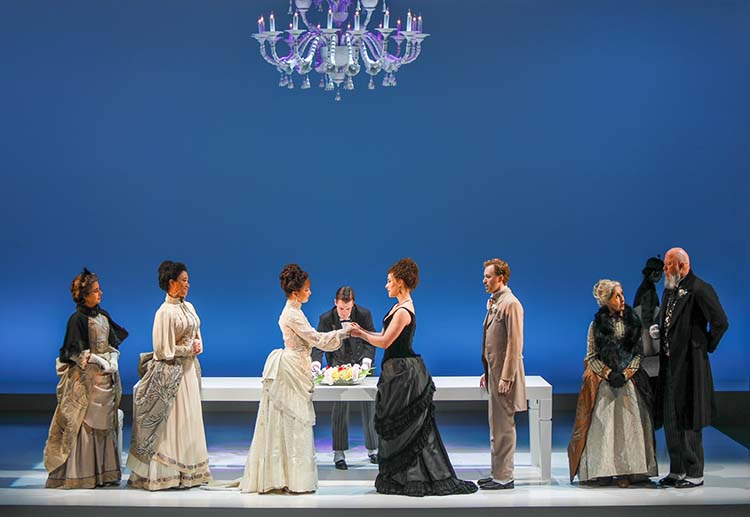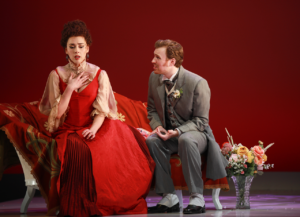
By Sandi Masori


SAN DIEGO — When you walk into The Old Globe’s main theater, the first thing you notice is the stark bright white stage with some chairs strewn around haphazardly. Except for the chandelier hanging from the ceiling it looks sleek and ultramodern.
This juxtaposition of modern vs historical continues throughout the play The Age of Innocence, which is based on the 1921 Pulitzer Prize-winning book of the same title by Edith Wharton. This stage version was adapted by playwright Karen Zacarias who was commissioned by The Old Globe.
While the main actors are dressed in garments that would fit well among New York’s aristocracy in the 1870s, the narrator (Eva Kaminsky) is wearing a modern pantsuit.
The story itself centers on a love triangle between Newland Archer (Callum Adams), Countess Ellen Olenska (Shereen Ahmed), and May Wellend (Delphi Borich). Countess Olenska returns to America after fleeing her abusive husband in Europe. She thinks and dresses very differently than the rest of New York society causing her to scandalize some and be idolized by others. Her cousin May is more what a high society girl should be with the “right” interests and attitude. The play also explores the place of women and their independence (or lack there of) as Ellen’s family keeps trying to pressure her to return to her abuser to save the rest of the family from gossip and dishonor. The only one who seems to understand Ellen’s need to remain free is Newland, who though he marries her cousin May, seems more than willing to throw everything away to pursue an affair with the countess.
The action is kept moving by the anachronistic narrator, who provides some comic relief. The use of the narrator is strange at times though, as she tells us things that we can clearly see, or that could easily be acted out. For example, in one scene she tells us how someone opens a window and leans out. Granted this story telling device does allow scenic designer Arnulfo Maldonado to maintain an incredibly minimalistic set rather than needing to move detailed props and scenery around.
While Kaminsky describes to us the opulence of each setting, for the most part, there is a single central piece of furniture on the stage. Behind it, running the length of the stage is an LED screen that changes colors to differentiate the opera from the art museum or one of the characters’ homes. Maldonado also makes good use of an elevator that raises and lowers a long table from the floor to knee height, to full table height as it becomes a bench, a carriage, or a banquet table.
The narrator opens the show by explaining to us that the timeline is set in New York’s gilded age, a time when many immigrants are coming through New York, including “Irish and Jewish.” Based on that reference, I was waiting for some sort of Jewish storyline or tie-in, but that is all we get. I’m not sure why that line was even in there, except perhaps historical accuracy?
Most likely I was the only one in the audience looking for such a connection, but all the same I found myself overanalyzing as I waited for the dots to line up. Perhaps, I thought, because all the actors use a quasi-English accent, and Grannie Mingott (Socorro Santiago) sounds more like a New Yorker, perhaps she is in fact Jewish. But when the characters started talking about an upcoming Christening, that notion was dispelled. I’m not sure why Grannie has a different accent and energy than the rest, though every time Santiago comes onstage in that role she is a breath of fresh air (she also plays Mrs. Van Der Luyden.)
Adams at times seems stiff and wooden compared to his more seasoned castmates, especially the phenomenally talented Ahmed, whose character Ellen is the most alive and developed in the show. Ahmed really stands out in that even in her stillness she is commanding. And I must give credit to an absolutely delicious scene between Ahmed and Adams, where they draw out and savor the sexual tension with the most seductive hand holding and glove removal I’ve ever seen. That is the most captivating moment in the show.
The second half of the show moves much quicker than the first, and the scenes are longer and more engaging as well. Besides Ahmed and Santiago, Mahira Kakkar deserves recognition for her dual role of Mrs. Welland and Medora Manson. I particularly liked her in her Medora persona.
Although the show posed many questions for me as to why they did this or that, overall I enjoyed the production notwithstanding the ending, which seemed abrupt to me.
The Age of Innocence is at The Old Globe through March 10.
*
Sandi Masori is a theater and restaurant reviewer for San Diego Jewish World.
Callum was awesome.
Sandi, we just saw this play and were sorely disappointed. I agree with many of your comments. The best part of the play were the costumes, but the minimalist set was inappropriate and contrasted in a negative way with the idea of a gilded age. The narrator took us away from the “action” each time she interrupted the performance and spoke, and it became a distraction. I’ve loved nearly every play we’ve seen at the Old Globe but this was not one of them.